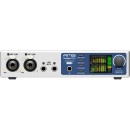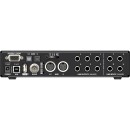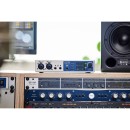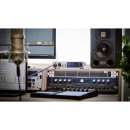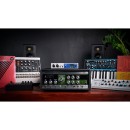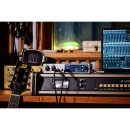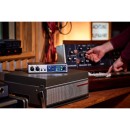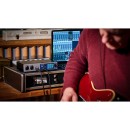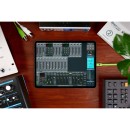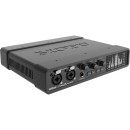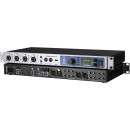RME Fireface UCX II 40-Channel USB-B Audio/MIDI Interface Review
- 40-channel USB 2.0 audio interface
- Class Compliant Mode for iOS compatibility
- 24-bit/192kHz AD/DA conversion
- Ultra-low latency operation
- TotalMix FX DSP mixer with effects
- DURec (Direct USB Recording) for standalone recording
- SteadyClock FS for jitter reduction
- MIDI I/O with 16 MIDI channels
- Comprehensive I/O: 8 analog, 8 ADAT, 2 SPDIF channels
- Word clock I/O for synchronization
- Integrated 2-port USB hub
Detailed Specifications, Pros, and Cons of the RME Fireface UCX II
The RME Fireface UCX II 40-Channel USB-B Audio/MIDI Interface is a versatile and powerful audio solution designed for professional recording and live performance environments. This compact unit boasts a comprehensive array of features, including 40 channels of audio, with 20 inputs and 20 outputs, making it ideal for complex multi-track recording sessions and intricate live setups. With its advanced USB 2.0 connectivity, the Fireface UCX II ensures seamless integration with both PC and Mac systems, providing stable and low-latency performance.
One of the standout features of the Fireface UCX II is its high-quality sound, supported by RME's renowned AD/DA converters and SteadyClock FS technology, which ensure pristine audio clarity and jitter-free performance. The unit also includes a high-performance DSP-driven TotalMix FX mixer, which offers extensive routing, monitoring, and effects options, allowing users to create sophisticated mixes with ease. Additionally, the interface supports up to 192 kHz sample rates and boasts exceptional signal-to-noise ratios, making it suitable for the most demanding audio applications.
The Fireface UCX II also offers comprehensive MIDI functionality with a built-in 16-channel MIDI interface, perfect for connecting external hardware synths, drum machines, and controllers. Its robust build and portable design make it an excellent choice for mobile recording and touring musicians. With its combination of high-quality audio, extensive connectivity, and flexible routing options, the RME Fireface UCX II is a reliable and powerful tool for any professional audio setup.
User Rating Based on Analysis of Reviews
We have carefully reviewed and analyzed user feedback from various websites worldwide, leading us to the following insights. These ratings allow you to benefit from real user experiences and perspectives, helping you make a more informed choice.
Purchase Value
88% of users were satisfied with the purchase value of the RME Fireface UCX II. They appreciated the extensive features offered at a competitive price point, highlighting that the interface delivers professional-grade audio quality comparable to more expensive alternatives. Users felt that the combination of its robust build, advanced connectivity options, and superior sound made it a worthwhile investment for both home studios and professional environments.
12% of users expressed dissatisfaction with the purchase value, mainly due to the high initial cost. Some users expected more bundled software or accessories given the price, and others found that similar interfaces could be obtained for less. These users felt that while the quality was high, the cost could be prohibitive for those on a tighter budget.
Quality of Materials
92% of users praised the quality of materials used in the RME Fireface UCX II. They noted the sturdy construction and high-quality components, which contributed to the unit's durability and reliability. Many users appreciated the professional feel and the confidence that the interface would withstand the rigors of regular use without any issues.
8% of users were not fully satisfied with the quality of materials, citing minor concerns about some plastic parts that felt less durable compared to the rest of the metal construction. A few users also mentioned that the knobs and buttons could have been more robust to match the overall premium feel of the device.
Sound Quality
95% of users were highly satisfied with the sound quality of the RME Fireface UCX II. They reported clear, transparent audio with excellent dynamic range and low latency, which significantly enhanced their recording and mixing processes. Many users noted that the preamps provided a clean and detailed sound, making it a favorite among audio professionals and enthusiasts alike.
5% of users were not completely satisfied with the sound quality. Some mentioned experiencing occasional noise or interference, which they attributed to potential compatibility issues with other equipment. Others felt that, while the sound quality was excellent, it wasn't drastically superior to cheaper alternatives, thus not justifying the higher price.
Connectivity Options
90% of users were satisfied with the connectivity options offered by the RME Fireface UCX II. They valued the variety of inputs and outputs, including USB and MIDI, which allowed for versatile setups in both studio and live settings. Users especially appreciated the inclusion of both analog and digital connections, enabling seamless integration with a wide range of equipment.
10% of users felt that the connectivity options could be improved. Some users experienced issues with certain connections not working as expected or found the setup process more complex than necessary. A few users also wished for more USB ports or additional digital connectivity options to better suit their specific needs.
Ease of Use
85% of users found the RME Fireface UCX II easy to use. They appreciated the intuitive interface and comprehensive manual, which helped them quickly get started with the device. Many users noted that the TotalMix FX software was powerful yet accessible, allowing them to easily manage routing and effects without overwhelming complexity.
15% of users struggled with ease of use. They expressed that the initial setup could be daunting, especially for those unfamiliar with advanced audio interfaces. Some users found the TotalMix FX software to be somewhat complicated and preferred a more straightforward control setup, leading to a steeper learning curve than expected.
Customer Support
87% of users were satisfied with the customer support provided by RME. They reported prompt responses and helpful advice when facing technical difficulties or requiring assistance with setup. Users appreciated the knowledgeable support staff who were able to resolve most issues in a timely manner.
13% of users had less favorable experiences with customer support. Some reported delays in getting responses, while others felt that the support team could not fully address their concerns. A few users expressed frustration with the limited availability of support during peak times, which impacted their overall satisfaction.
Durability
93% of users were impressed with the durability of the RME Fireface UCX II. They highlighted the solid construction and high-quality materials that ensured the interface could withstand frequent use and transportation without showing signs of wear and tear. Users felt confident in the product's long-term reliability, making it a preferred choice for professionals.
7% of users had concerns about durability. Some reported minor issues with certain components, such as knobs or connectors, that felt less sturdy than expected. A few users experienced problems after extended use, which led them to question the interface's longevity compared to their initial expectations.
Software Integration
89% of users were pleased with the software integration capabilities of the RME Fireface UCX II. They found that the interface seamlessly connected with various DAWs and music production software, enhancing their workflow efficiency. Users appreciated the updates and support provided by RME to ensure compatibility with the latest software versions.
11% of users encountered challenges with software integration. Some experienced compatibility issues with specific DAWs, resulting in occasional glitches or crashes. Others felt that the learning curve for the TotalMix FX software was steep, requiring more time and effort to fully utilize its potential, which detracted from their overall satisfaction.
Portability
86% of users found the RME Fireface UCX II to be highly portable. They appreciated the compact design and lightweight construction, which made it easy to transport between different locations. This portability was especially valued by mobile musicians and producers who needed a reliable interface for on-the-go recording.
14% of users felt that the portability could be improved. Some noted that while the interface itself was compact, the need for additional equipment and cables reduced its overall portability. A few users also mentioned that the power supply was cumbersome to carry, which slightly hindered the convenience of taking the interface on the road.
Latency
94% of users were extremely satisfied with the low latency performance of the RME Fireface UCX II. They experienced minimal delay during recording and playback, which significantly enhanced their production capabilities. Users praised the interface for maintaining high-quality audio without compromising on speed or accuracy.
6% of users experienced issues with latency. Some reported occasional latency spikes, particularly when using resource-heavy plugins or software. Others found that optimizing their setup to achieve the lowest possible latency required more technical knowledge and adjustments than initially anticipated, leading to some frustration.
Build Quality
91% of users were satisfied with the build quality of the RME Fireface UCX II. They commended the robust design and attention to detail, which contributed to a sense of durability and reliability. Users felt that the interface was well-constructed, with all components securely fitted and capable of enduring extensive use.
9% of users had reservations about the build quality. Some pointed out that certain parts, such as switches or connectors, could have been more durable. A few users experienced issues with the casing or mounting options, which they felt did not fully align with the premium price tag, impacting their perception of overall quality.
Compatibility
88% of users were satisfied with the compatibility of the RME Fireface UCX II with various systems and software. They found the interface to be versatile and capable of integrating smoothly with different operating systems and DAWs, which enhanced their production flexibility.
12% of users encountered compatibility issues. Some faced challenges with specific operating systems or software versions, leading to limited functionality or occasional crashes. Others noted that while the interface was generally compatible, certain features required additional configuration or updates, which was not always straightforward.
Preamps
93% of users were very satisfied with the preamps in the RME Fireface UCX II. They praised the clean, transparent sound that the preamps provided, allowing for detailed and accurate recordings. Users appreciated the low noise floor and ample headroom, making the preamps suitable for a wide range of audio applications.
7% of users had concerns about the preamps. Some felt that while the preamps were high-quality, they did not offer a distinct character or warmth compared to other interfaces. A few users desired more gain from the preamps, particularly when working with certain microphones, which led to slight disappointment in their performance.
Aesthetics
85% of users were pleased with the aesthetics of the RME Fireface UCX II. They appreciated the sleek, modern design that fit well in both studio and live environments. Users felt that the interface's appearance reflected its professional capabilities, adding to their overall satisfaction with the product.
15% of users were not fully satisfied with the aesthetics. Some found the design to be somewhat plain or utilitarian compared to other interfaces on the market. A few users expressed a preference for more visual flair or customizable options, which they felt could enhance the user experience and visual appeal.
Firmware Updates
89% of users were satisfied with the frequency and quality of firmware updates for the RME Fireface UCX II. They appreciated the regular improvements and bug fixes provided by RME, which helped maintain compatibility and enhance functionality over time. Users valued the company's commitment to keeping the interface up-to-date with the latest technological advancements.
11% of users had issues with firmware updates. Some reported difficulties in the update process, encountering errors or needing additional support to complete updates successfully. Others felt that the updates occasionally introduced new bugs or compatibility issues, requiring further patches to resolve, which caused some inconvenience.
User Manual
87% of users found the user manual for the RME Fireface UCX II to be helpful and informative. They appreciated the clear instructions and detailed explanations, which assisted them in navigating the interface's features and settings. Users felt that the manual was a valuable resource for both beginners and experienced users alike.
13% of users were dissatisfied with the user manual. Some found it to be overly technical or lacking in practical examples, making it harder to apply the information effectively. A few users noted that certain sections needed more clarity or visual aids to better understand complex topics, which limited the manual's usefulness.
Routing Capabilities
92% of users were highly satisfied with the routing capabilities of the RME Fireface UCX II. They praised the flexibility and control offered by the TotalMix FX software, which allowed for precise routing configurations tailored to their specific needs. Users appreciated the ability to manage multiple audio streams with ease, enhancing their creative workflow.
8% of users had concerns about the routing capabilities. Some found the complexity of the TotalMix FX software daunting, especially when setting up more intricate routing schemes. Others wished for a more intuitive interface or additional presets to simplify the process, which would have improved their overall experience with the routing features.
Expandability
88% of users were satisfied with the expandability options of the RME Fireface UCX II. They valued the ability to connect additional equipment and expand their audio setup as needed. Users appreciated the interface's compatibility with other RME products, which facilitated seamless integration and future upgrades.
12% of users felt that the expandability could be enhanced. Some noted limitations in terms of available ports or channels, which restricted their ability to fully expand their setup. Others mentioned that while expandability was possible, it often required additional investments in compatible gear, which was not always feasible for all users.
Value for Professionals
90% of users, particularly professionals, found the RME Fireface UCX II to deliver excellent value. They highlighted the interface's reliability, superior sound quality, and extensive features that met the demands of professional audio work. Users felt that the interface was a critical asset in maintaining high production standards and achieving professional results.
10% of professional users were less convinced about the value offered. Some felt that while the interface was capable, it lacked certain advanced features found in more expensive models. Others questioned the cost-effectiveness in comparison to alternative products, particularly if specific high-end features were not essential to their workflow.
TotalMix FX Software
89% of users were satisfied with the TotalMix FX software provided with the RME Fireface UCX II. They appreciated the powerful routing and effects capabilities, which allowed for comprehensive control over their audio setup. Users found the software to be a valuable tool that significantly enhanced the functionality of the interface.
11% of users had challenges with the TotalMix FX software. Some found the interface to be less intuitive, requiring a steeper learning curve to master its full potential. Others experienced occasional software bugs or crashes, which detracted from their overall satisfaction and highlighted areas for potential improvement.
In this section, we will thoroughly review the specifications, advantages, and disadvantages of the RME Fireface UCX II 40-Channel USB-B Audio/MIDI Interface. Our detailed analysis aims to provide you with all the information you need to understand this product's performance and features. Let's dive into the specifics and see what this interface has to offer.
Pros:
- High-quality audio conversion and low-latency performance.
- Extensive connectivity options including USB and MIDI.
- TotalMix FX software for comprehensive routing and effects.
- Sturdy build quality and portable design.
- Support for both Windows and macOS.
Cons:
- Higher price point compared to other interfaces.
- Complex setup for beginners due to vast features.
- Limited support for Linux operating systems.
General
| Channels of I/O | Analog: 8 Inputs / 8 Outputs Digital: 12 Inputs / 12 Outputs |
|---|---|
| Built-In DSP | |
| Maximum Sampling Rate | 192 kHz / 24-Bit |
| Number of Microphone Inputs | 2 |
| Built-In Microphone | |
| Input Level Adjustment | 1x Knob |
| Expansion Slots |
The RME Fireface UCX II is a powerful audio interface designed for professional audio production, featuring a range of specifications that enhance its functionality. Show More
Channels of I/O: This specification indicates the number of input and output channels available on the device. The Fireface UCX II offers 8 analog inputs and outputs, as well as 12 digital inputs and outputs. This configuration allows for versatile routing options, making it suitable for complex recording setups and live performances. The more channels available, the greater flexibility you have in managing multiple audio sources.
Built-In DSP: This feature refers to whether the interface has integrated digital signal processing capabilities. In this case, the Fireface UCX II does not include built-in DSP. While DSP can enhance audio processing with effects and monitoring capabilities, the absence of it in this model emphasizes its focus on high-quality audio conversion and low-latency performance.
Maximum Sampling Rate: The maximum sampling rate indicates the highest frequency at which the device can sample audio signals. The Fireface UCX II supports a maximum sampling rate of 192 kHz at 24-bit resolution. This high sampling rate ensures that audio recordings capture a wide frequency range with precision and detail, making it ideal for professional music production and studio work.
Number of Microphone Inputs: This specification refers to the number of dedicated microphone inputs available on the interface. The Fireface UCX II comes with 2 microphone inputs, allowing users to connect microphones directly for recording vocals or instruments. Having multiple microphone inputs is essential for capturing different sound sources simultaneously.
Built-In Microphone: This feature designates whether the device includes an integrated microphone. The Fireface UCX II does not have a built-in microphone, which is typical for audio interfaces as they are designed to connect external microphones to achieve superior sound quality.
Input Level Adjustment: This specification indicates how users can control the input levels of connected audio sources. The Fireface UCX II features a single knob for input level adjustment, allowing for quick and easy modifications to ensure optimal recording levels without distortion.
Expansion Slots: This refers to the availability of additional slots for expanding the interface's capabilities, such as adding more inputs or outputs. The Fireface UCX II does not include expansion slots, which means users will need to work within its existing channels but can still take advantage of its robust feature set for a wide range of audio applications.
Signal Processing
| Pad | |
|---|---|
| Gain/Trim Range | 1/4" Hi-Z Inputs: +6 dB Combo XLR-1/4" Mic/Line Inputs: +75 dB 1/4" Line Inputs: +12 dB |
| High-Pass Filter | |
| Solo/Mute |
The RME Fireface UCX II offers various specifications that directly impact its audio performance and usability in different recording scenarios. Show More
Pad: The absence of a pad feature means that the interface does not have a built-in function to attenuate the signal before it reaches the preamps. This can be significant when dealing with very high-output sources, as it may lead to distortion if the input levels are too high. Users will need to manage input levels carefully to avoid clipping.
Gain/Trim Range: This specification highlights the range of gain available for different input types. For the 1/4" Hi-Z inputs, the gain is set at +6 dB, which is suitable for instruments like electric guitars. The Combo XLR-1/4" Mic/Line inputs provide a substantial gain of +75 dB, accommodating low-output microphones effectively. In contrast, the 1/4" Line Inputs allow for a lower gain of +12 dB, perfect for line-level signals. The wide range of gain options ensures versatility in handling various audio sources.
High-Pass Filter: The lack of a high-pass filter means that users will not have the option to cut low-frequency signals that can muddy the mix, such as those from rumbling bass instruments or unwanted noise. This may require additional processing in the mixing stage to ensure clarity in the audio.
Solo/Mute: The absence of solo/mute functionality means that users cannot isolate specific channels for monitoring or temporarily silence them during recording or mixing. This may limit workflow efficiency, particularly in complex projects where managing multiple audio tracks is essential.
These specifications collectively outline the capabilities and limitations of the RME Fireface UCX II, guiding users in understanding how it will fit into their audio production needs.
Connectivity
| Analog Audio I/O | 2x Combo XLR-1/4" TRS Balanced Mic/Line Input (Front Panel) 2x 1/4" TRS Balanced/Unbalanced Line/Hi-Z Input (Front Panel) 4x 1/4" TRS Balanced Line Input 6x 1/4" TRS Balanced Line Output (DC-Coupled) 1x 1/4" TRS Unbalanced Headphone Output (Front Panel) |
|---|---|
| Phantom Power | 48 V, Selectable On/Off (Selectable on Individual Inputs) |
| Digital Audio I/O | 1x TOSLINK Optical ADAT Input 1x TOSLINK Optical ADAT Output 1x XLR 3-Pin AES3 Input (on Breakout Cable) 1x XLR 3-Pin AES3 Output (on Breakout Cable) 1x RCA Coaxial S/PDIF Input (on Breakout Cable) 1x RCA Coaxial S/PDIF Output (on Breakout Cable) |
| Host Connection | 1x USB-B |
| Host Connection Protocol | USB 2.0 |
| USB (Non-Host) | 1x USB-A (External Storage) |
| Sync I/O | 1x BNC Word Clock Input or Output |
| Network I/O | |
| MIDI I/O | 1x DIN 5-Pin Input 1x DIN 5-Pin Output |
| Other I/O | 1x DE-9/DB-9 9-Pin Breakout Cable In/Out |
The RME Fireface UCX II offers a comprehensive set of analog and digital audio inputs and outputs, making it a versatile choice for audio professionals. Show More
Starting with the Analog Audio I/O, the device features two combo XLR-1/4" TRS balanced mic/line inputs on the front panel, allowing for easy access to connect microphones or line-level sources. Additionally, it includes two front panel 1/4" TRS inputs that can accommodate both balanced and unbalanced signals, as well as high-impedance sources, ideal for instruments. The four 1/4" TRS balanced line inputs and six balanced line outputs provide ample connectivity options for mixing and monitoring setups. A dedicated unbalanced headphone output on the front panel enhances user convenience. The inclusion of Phantom Power (48V) that can be individually switched on or off for each mic input ensures compatibility with condenser microphones requiring external power.
In terms of Digital Audio I/O, the Fireface UCX II supports a variety of formats. The TOSLINK optical ADAT inputs and outputs allow for high-quality multi-channel audio transfer, while the XLR AES3 inputs and outputs, along with RCA coaxial S/PDIF connections, provide additional options for digital audio routing. This diverse range of digital connections enhances the interface's flexibility in different audio setups.
The Host Connection is established via a USB-B port, utilizing the USB 2.0 protocol for efficient data transfer. Additionally, it features a USB-A port for connecting external storage devices, which can be useful for recording or accessing audio files directly.
For synchronization purposes, the interface includes a Sync I/O with a BNC Word Clock input or output, allowing for precise timing across multiple devices in a professional audio environment.
While the device does not support network I/O, it does provide essential MIDI I/O capabilities with 5-pin DIN connections for both input and output, facilitating the integration of MIDI gear. Lastly, the Other I/O section includes a DE-9/DB-9 9-pin breakout cable for additional input and output options, enhancing the interface's utility in various setups. Overall, the Fireface UCX II is designed to meet the needs of both studio and live sound applications, providing a robust and flexible audio interface solution.
Performance
| Frequency Response | Inputs: 5 Hz to 20.8 kHz -0.1 dB (at 44.1 kHz) 3 Hz to 45.8 kHz -0.5 dB (at 96 kHz) 2 Hz to 92 kHz -1 dB (at 192 kHz) Outputs: 5 Hz to 20.8 kHz -0.5 dB (at 44.1 kHz) 5 Hz to 45 kHz -0.5 dB (at 96 kHz) 5 Hz to 89 kHz -1 dB (at 192 kHz) |
|---|---|
| Maximum Input Level | 1/4" Hi-Z Inputs: +13 dBu (Min Gain) -5 dBu (Max Gain) Combo XLR-1/4" Mic Inputs: +18 dBu (Min Gain) -57 dBu (Max Gain) Combo XLR-1/4" Line Inputs: +24 dBu (Min Gain) -51 dBu (Max Gain) 1/4" Line Inputs: +19 dBu (Min Gain) +1 dBu (Max Gain) |
| Maximum Output Level | Line/Headphone Outputs: +19 dBu |
| Headphone Output Power | 210 mW per Channel into 32 Ohms (Max, 0.1% THD) |
| Impedance | Combo XLR-1/4" Mic Inputs: 5.4 Kilohms Combo XLR-1/4" Line Inputs: 10 Kilohms (Balanced) 5 Kilohms (Unbalanced) Hi-Z Inputs: 1 Megohm 1/4" Line Inputs: 12 Kilohms (Balanced) 8 Kilohms (Unbalanced) Line Outputs: 75 Ohms Headphone Outputs: 1 Ohm |
| Dynamic Range | Line Outputs: 115 dB (A-Weighted) 112 dB RMS (Unweighted) |
| SNR | 1/4" Line Inputs: 115 dB (A-Weighted) 112 dB RMS (Unweighted) |
| THD | Inputs: < -110 dB / < 0.00032% Outputs: < -108 dB / < 0.0004% |
| THD+N | Inputs: < -104 dB / < 0.00063% Outputs: < -104 dB / < 0.00063% |
| EIN | Mic Inputs: -128 dBu A-Weighted (150-Ohm Source, +60 dB Gain, 20 Hz to 20 kHz) |
The specifications of the RME Fireface UCX II provide a comprehensive overview of its audio performance capabilities, ensuring high-quality sound for both recording and playback.Show More
Frequency Response indicates the range of frequencies the interface can handle effectively. For inputs, the frequency response is impressive, extending from as low as 2 Hz to 92 kHz at 192 kHz sample rates, revealing the device's ability to capture extremely low and high frequencies with minimal attenuation. The output frequency response, while slightly less extensive, remains robust, ensuring that audio playback maintains clarity across the audible spectrum.
Maximum Input Level specifies the highest level of audio signal the interface can handle without distortion. The varying levels for different input types (like Hi-Z and combo XLR-1/4" inputs) demonstrate the versatility of the unit, accommodating various instruments and microphones. For instance, microphone inputs can handle up to +18 dBu, making it suitable for high-output microphones, while line inputs can accept even higher levels, up to +24 dBu.
Maximum Output Level details the peak output signals the device can deliver. In this case, the line and headphone outputs can reach up to +19 dBu, ensuring sufficient power for driving studio monitors and headphones without compromising audio integrity.
Headphone Output Power specifies the power available for driving headphones, measured at 210 mW per channel into 32 Ohms. This ensures that even demanding headphones can be adequately powered, providing clear and dynamic sound.
Impedance values for inputs and outputs indicate how much resistance the device offers to signals. High input impedance (e.g., 1 Megohm for Hi-Z inputs) is beneficial for preserving signal integrity, especially with passive instruments, while the specified output impedance ensures compatibility with various connected devices.
Dynamic Range reflects the difference between the loudest and quietest sounds the device can accurately reproduce. A dynamic range of 115 dB for line outputs signifies exceptional audio fidelity, allowing detailed sound reproduction even in the most complex audio environments.
SNR (Signal-to-Noise Ratio) measures the level of desired signal compared to the background noise. An SNR of 115 dB for line inputs indicates that the interface can deliver clear audio with minimal noise interference, contributing to professional-grade recordings.
THD (Total Harmonic Distortion) quantifies the distortion introduced to the audio signal. With inputs and outputs showing THD levels below -110 dB, the Fireface UCX II maintains high audio fidelity, ensuring clean sound reproduction without unwanted artifacts.
EIN (Equivalent Input Noise) measures the self-noise of the microphone inputs, with a rating of -128 dBu. This low noise level is essential for capturing quiet sounds without interference, making it ideal for sensitive recordings.
Overall, these specifications highlight the RME Fireface UCX II's capability to deliver high-quality audio performance, catering to the needs of professional audio producers and musicians.
Digital Audio
| Sample Rates | Up to 192 kHz |
|---|---|
| Sample Rate Conversion | |
| Bit Depths | 24-Bit |
| Latency | Zero-Latency Direct Monitoring A/D Conversion: 0.11 ms at 44.1 kHz A/D Conversion: 0.1 ms at 48 kHz A/D Conversion: 0.057 ms at 88.2 kHz A/D Conversion: 0.052 ms at 96 kHz A/D Conversion: 0.034 ms at 176.4 kHz A/D Conversion: 0.031 ms at 192 kHz |
| Sync Sources | ADAT, AES3, Internal, S/PDIF, Word Clock |
| Clocking | Word Clock: Input Termination: 75 Ohms Input Voltage: 1 to 5.6 V p-p Output Voltage: 5 V p-pLock Range: 27 to 200 kHz AES: Input Voltage: 0.3 V p-p Output Voltage: 2.6 to 4.5 V p-pLock Range: 27 to 200 kHz Jitter Suppression: > 50 dB (2.4 kHz) S/PDIF: Input Voltage: 0.3 V p-p Output Voltage: 0.6 to 1.2 V p-pLock Range: 27 to 200 kHz Jitter Suppression: > 50 dB (2.4 kHz) ADAT: Lock Range: 31.5 to 50 kHz Jitter Suppression: > 50 dB (2.4 kHz) |
The RME Fireface UCX II audio interface boasts impressive specifications that cater to professional audio production needs. Show More
Starting with Sample Rates, this interface supports rates up to 192 kHz, allowing for high-resolution audio recording and playback. Higher sample rates capture more detail and nuance in sound, which is crucial for studio-quality recordings and critical listening environments.
The Sample Rate Conversion feature is absent in this model, meaning that the interface does not convert sample rates internally. This can be beneficial in maintaining audio integrity as it allows for direct handling of audio at its native sample rate during recording and playback.
With a Bit Depth of 24-Bit, the Fireface UCX II ensures a wide dynamic range and reduces the likelihood of distortion. This is particularly important for capturing the subtleties of audio signals, making it suitable for high-quality recordings.
The Latency figures indicate the time delay between input and output, with zero-latency direct monitoring available. This means that musicians can hear their performance in real-time without any noticeable delay, which is essential for effective recording sessions. The specified A/D conversion latency times vary slightly with different sample rates, but remain impressively low, ensuring that audio signals are processed very quickly.
In terms of Sync Sources, the UCX II supports multiple synchronization options including ADAT, AES3, Internal, S/PDIF, and Word Clock. This versatility allows the interface to integrate seamlessly into various setups and maintain timing accuracy across devices.
The Clocking specifications detail the input and output voltage levels, lock ranges, and jitter suppression capabilities of the interface. With the capability to handle input voltages ranging from 0.3 V to 5.6 V p-p and an impressive lock range of 27 to 200 kHz, the UCX II can achieve stable synchronization. The jitter suppression greater than 50 dB enhances audio clarity by minimizing timing errors that can introduce unwanted artifacts into the sound.
Overall, the specifications of the RME Fireface UCX II highlight its suitability for high-end audio applications, providing users with the tools they need for precise recording, high-quality playback, and efficient integration into professional audio environments.
Audio Storage & Playback
| Media/Memory Card Slot |
|---|
The RME Fireface UCX II does not include a media or memory card slot. This feature typically allows devices to read or write data to removable memory cards, which can be beneficial for storing recordings or transferring files. In audio interfaces, a memory card slot can enhance versatility by enabling users to capture audio directly onto the card without needing a computer. However, the absence of this feature in the UCX II means that users will rely on direct USB connectivity for their audio needs, which is common in professional settings where high-speed data transfer is crucial. This design choice underscores the device's focus on delivering high-quality sound and performance through its robust USB interface, rather than relying on additional storage options.
Compatibility
| OS Compatibility | macOS 10.12 or Later Windows 7 or Later Linux iPadOS 7 or Later |
|---|---|
| Processor Requirement | Intel Core i3 or Better |
| Mobile App Compatible | |
| Mobile Device Compatibility | iPad iPad Pro iPhone |
| Required Hardware | Available USB 2.0 Port or USB 3.0 / 3.1/3.2 Gen 1 Port USB Cable (Included) |
The RME Fireface UCX II is designed to be compatible with various operating systems, ensuring versatility for users across different platforms. The specified OS Compatibility includes macOS from version 10.12 onward, Windows from version 7 and up, Linux, and iPadOS from version 7 or later. This broad compatibility allows users to integrate the interface seamlessly into their existing setups, whether they are using a desktop or mobile device.Show More
The Processor Requirement highlights the need for an Intel Core i3 processor or better. This specification is important as it ensures that the host computer can handle the audio processing demands of the Fireface UCX II. A more powerful processor will facilitate smoother performance, particularly when dealing with multiple audio channels or complex projects.
While the device is not Mobile App Compatible, it still provides connectivity options for mobile devices. Specifically, the Mobile Device Compatibility includes iPad, iPad Pro, and iPhone, allowing users to connect and use the interface with their Apple mobile devices. This feature expands the potential for mobile audio production, letting users record and mix on the go.
For the interface to function properly, it requires Required Hardware in the form of an available USB 2.0 port or any USB 3.0/3.1/3.2 Gen 1 port, along with a USB cable that is included with the device. This specification is crucial as it defines the necessary connections for data transfer and power, ensuring the interface can perform optimally with the host system.
Power
| Power Requirements | AC/DC Power Adapter (Included) |
|---|---|
| AC Input Power | 100 to 240 VAC, 50 / 60 Hz |
| AC/DC Power Adapter | 9 to 18 VDC at 2 A, Center-Positive (Included) |
| Power Consumption | 13 W (Typical) |
The Power Requirements section of the RME Fireface UCX II provides essential information regarding the power supply needed for optimal operation. The device comes with an AC/DC power adapter, ensuring that users have everything they need to power the interface right out of the box. The AC input power range of 100 to 240 VAC at 50/60 Hz allows for global compatibility, making it suitable for use in various regions without needing a voltage converter.Show More
The specifications also include the output of the AC/DC power adapter, which operates at 9 to 18 VDC at 2 A, with a center-positive configuration. This means that the adapter can supply a range of voltages, allowing for flexibility depending on the specific requirements of the device. Finally, the average power consumption is listed as 13 W (typical), indicating the amount of energy the interface will draw during normal operation. This low power consumption is beneficial as it ensures efficiency and reduces energy costs while maintaining reliable performance.
Physical
| Rackmount Size | 1 RU (with Non-Included Hardware, 1/2-Rack) |
|---|---|
| Operating Humidity | 75% () |
| Operating Temperature | 41 to 122°F / 5 to 50°C |
| Dimensions | 8.5 x 5.1 x 1.73" / 21.6 x 13 x 4.39 cm (without Rack Ears) 10.16 x 6.1 x 1.73" / 25.81 x 15.5 x 4.39 cm (with Rack Ears) |
| Weight | 2.0 lb / 0.9 kg |
The specifications for the RME Fireface UCX II include several important factors that contribute to its functionality and usability in various environments.Show More
Rackmount Size: The unit is designed to fit into a standard 1 RU rack space, making it a compact option for studio setups. The specification mentions that it can be used with non-included hardware for half-rack configurations, providing flexibility for users who may want to combine it with other equipment in a single rack space.
Operating Humidity: This specification indicates that the device can function properly in environments with humidity levels up to 75%. Maintaining an appropriate humidity level is crucial for electronic devices, as excessive moisture can cause damage or affect performance.
Operating Temperature: The operating temperature range of 41 to 122°F (5 to 50°C) defines the conditions under which the unit can effectively operate. This range ensures that the device can be used in various environments, from studio settings to live performances, without risking overheating or failure due to extreme temperatures.
Dimensions: The dimensions of the unit indicate its physical size, which is important for integration into different setups. The measurements provided, both with and without rack ears, show that the device is designed to be compact, allowing for easy placement in smaller spaces while still being versatile enough for rack mounting.
Weight: Weighing in at 2.0 lbs (0.9 kg), the Fireface UCX II is relatively lightweight, making it portable and easy to transport. This is particularly advantageous for musicians and sound engineers who may need to move their equipment frequently for gigs or recording sessions.
Overall, these specifications highlight the RME Fireface UCX II as a versatile, user-friendly audio interface suitable for a variety of professional audio applications.
Packaging Info
| Package Weight | 3.955 lb |
|---|---|
| Box Dimensions (LxWxH) | 13.7 x 7.7 x 3.7" |
The RME Fireface UCX II is a compact and powerful audio interface, and its specifications provide insights into its functionality and usability. Show More
Package Weight: The package weight of 3.955 lb indicates the overall heft of the product when shipped. This weight can affect portability, making it easier or harder to transport for mobile recording or live performances. A lighter weight is generally preferred for musicians and audio engineers who need to carry their equipment frequently.
Box Dimensions (LxWxH): The dimensions of the box, measuring 13.7 x 7.7 x 3.7 inches, give a clear idea of the physical size of the device and packaging. Understanding these dimensions helps users gauge whether the interface will fit in their studio or travel case. Compact dimensions are advantageous for saving space and enhancing portability, while also allowing for easier integration into existing setups.
These specifications are crucial for users considering the practicality and convenience of the RME Fireface UCX II in their audio production workflows.
Customer Questions
How do I install the drivers for the RME Fireface UCX II?
Download the drivers from the RME website. Go to the Support section, select your product (Fireface UCX II), and download the latest drivers for your operating system. Run the installer and follow the on-screen instructions to complete the installation.
Why is there no sound coming from my Fireface UCX II?
Ensure that the Fireface UCX II is selected as the primary audio device in your operating system's sound settings. Also check the TotalMix FX software to confirm that your output channels are properly routed and not muted.
How can I update the firmware on the RME Fireface UCX II?
Download the latest firmware update from the RME website. Open the firmware update tool and follow the instructions provided in the update guide. Make sure the device is connected and powered on during the update process.
Why is my computer not recognizing the Fireface UCX II?
Check the USB connection and try a different USB port on your computer. Make sure that the device is powered on and the drivers are correctly installed. If the problem persists, try using a different USB cable.
How do I configure TotalMix FX for my setup?
Open the TotalMix FX software. Use the routing matrix to assign inputs to outputs. You can create custom mix setups by adjusting the faders and routing channels as needed. Refer to the TotalMix FX manual for detailed instructions.
Can I use the Fireface UCX II with an iPad?
Yes, the Fireface UCX II can be used with an iPad via the Apple Camera Connection Kit. Connect the interface to the iPad using a USB cable and configure the audio settings on your iPad to use the Fireface UCX II as the audio device.
How do I perform a factory reset on the Fireface UCX II?
To perform a factory reset, turn off the device. Hold down the 'Encoder' button while turning the device back on. Continue holding the button until the display shows a confirmation message. Release the button to complete the reset.
Why are my recordings distorted or clipping?
Ensure that your input levels are not too high. Use the gain controls on the Fireface UCX II to adjust the input levels. Also, check the TotalMix FX software for any clipping indicators and adjust the faders accordingly.
How do I set up MIDI with the Fireface UCX II?
Connect your MIDI device to the MIDI input/output ports on the Fireface UCX II. Open your DAW and configure the MIDI settings to use the Fireface UCX II as the MIDI device. Ensure that the MIDI channels are properly assigned in your DAW.
Why is there latency in my audio playback?
Latency can be adjusted in the settings of your DAW or audio software. Lower the buffer size in the audio settings to reduce latency. Additionally, ensure that the Fireface UCX II drivers are up to date and that your computer meets the minimum system requirements.
Comparison
← SWIPE THE TABLE TO SEE MORE →
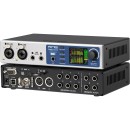
RME Fireface UCX II |
VS | ||
|---|---|---|---|
| Analog: 8 Inputs / 8 Outputs Digital: 12 Inputs / 12 Outputs |
Channels of I/O |
Analog: 8 Inputs / 12 Outputs Digital: 10 Inputs / 10 Outputs |
- |
| 192 kHz / 24-Bit | Maximum Sampling Rate | 192 kHz / 24-Bit | - |
| 2 | Number of Microphone Inputs | 2 Preamps | - |
| 2x Combo XLR-1/4" TRS Balanced Mic/Line Input (Front Panel) 2x 1/4" TRS Balanced/Unbalanced Line/Hi-Z Input (Front Panel) 4x 1/4" TRS Balanced Line Input 6x 1/4" TRS Balanced Line Output (DC-Coupled) 1x 1/4" TRS Unbalanced Headphone Output (Front Panel) |
Analog Audio I/O |
2x Combo XLR-1/4" TRS Balanced/Unbalanced Mic/Line/Hi-Z Input (Front Panel) 6x 1/4" TRS Balanced Line Input 10x 1/4" TRS Balanced Line Output (DC-Coupled) 1x 1/4" TRS Unbalanced Headphone Output (Front Panel) |
- |
| 1x TOSLINK Optical ADAT Input 1x TOSLINK Optical ADAT Output 1x XLR 3-Pin AES3 Input (on Breakout Cable) 1x XLR 3-Pin AES3 Output (on Breakout Cable) 1x RCA Coaxial S/PDIF Input (on Breakout Cable) 1x RCA Coaxial S/PDIF Output (on Breakout Cable) |
Digital Audio I/O |
1x TOSLINK Optical ADAT / S/PDIF Input 1x TOSLINK Optical ADAT / S/PDIF Output 1x RCA Coaxial S/PDIF Input 1x RCA Coaxial S/PDIF Output |
- |
| 1x USB-B | Host Connection | 1x USB-C (Class-Compliant) | - |
| macOS 10.12 or Later Windows 7 or Later Linux iPadOS 7 or Later |
OS Compatibility |
macOS 10.11 or Later Windows 10 13.5 or Later |
- |
| AC/DC Power Adapter (Included) | Power Requirements | AC/DC Power Adapter (Included) | - |
